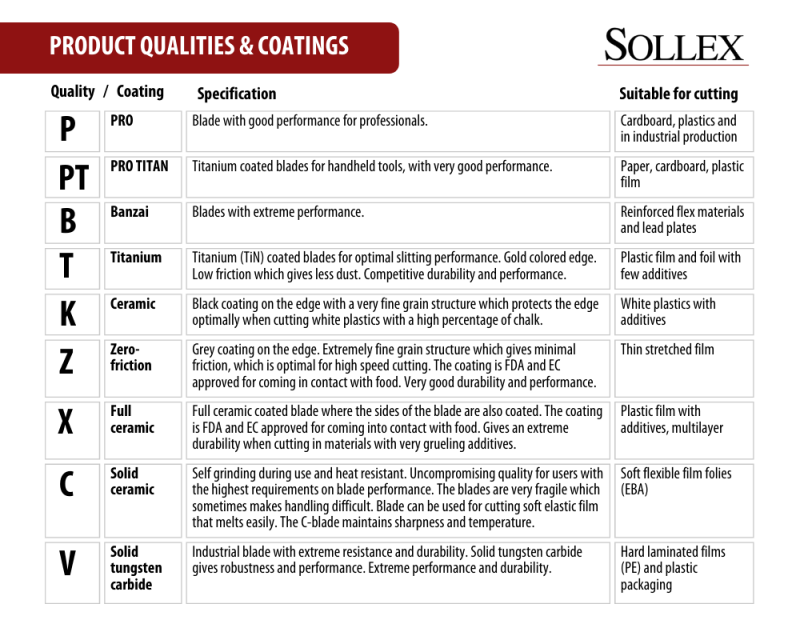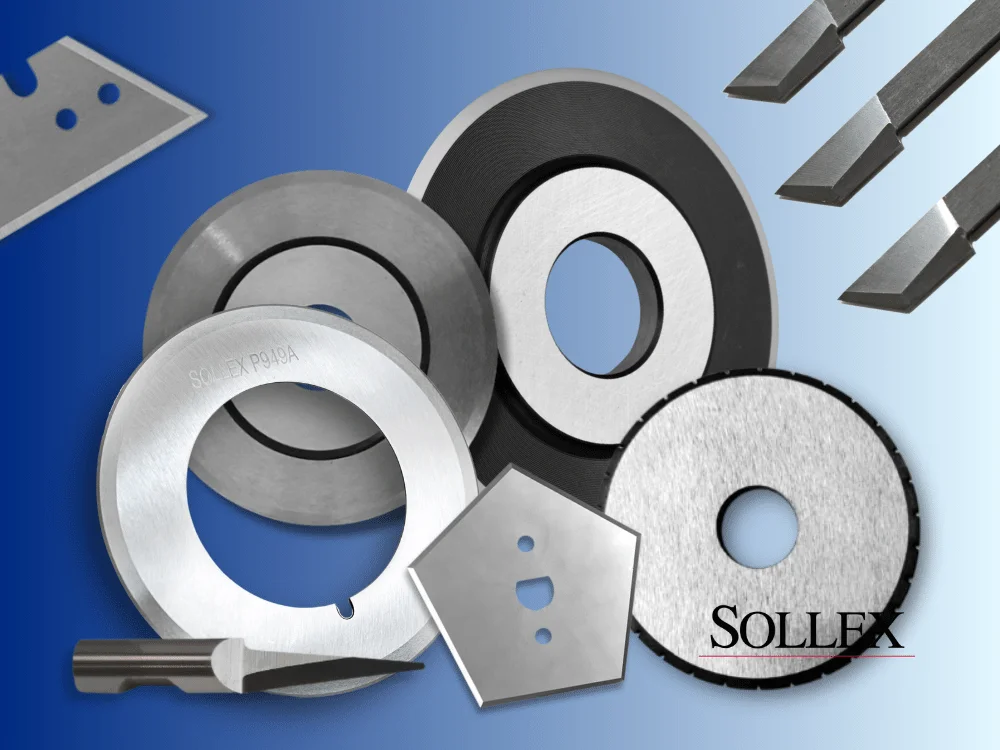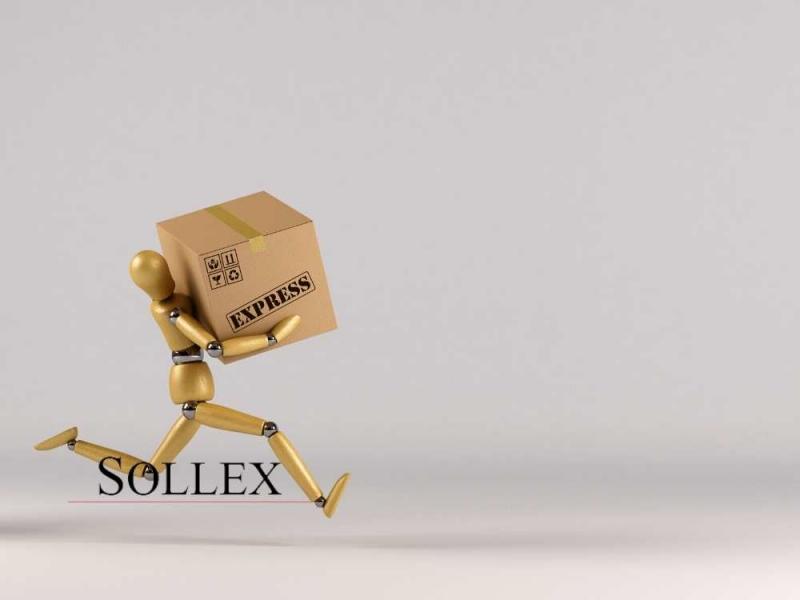4 Ways to Improve Slitter Knife Performance
The service life, cut quality, and efficiency of converting slitter machine knives may all be increased by improving their features and making adjustments to the knife's design. Upgrading current knives may frequently greatly increase their durability, efficiency, and overall performance, so replacing them entirely is not always the only way. In this post, we'll look at ways to enhance conversion knives, which could improve productivity and cutting quality in your production and converting processes.
1. Slitter Knife Design
 Improving your cutting process starts with selecting the appropriate slitting process and machine knife type, its dimensions, edge design, hardness, and sharpening. After you've come up with a workable solution, you should consider ways to make the cutting or slitting procedure more durable.
Improving your cutting process starts with selecting the appropriate slitting process and machine knife type, its dimensions, edge design, hardness, and sharpening. After you've come up with a workable solution, you should consider ways to make the cutting or slitting procedure more durable.
The very first step in cutting any sort of material is to identify the fundamental blade design. Slitter razor blades provide the thinnest and most exact cut for converting and cutting inline flexible materials like plastic film or foil. Straight and guillotine knives work well for crosscutting in the paper sector. Circular top slitting knives are used in slitting, particularly of rolled materials, and provide high performance by selecting the appropriate properties for the conversion of a certain material. In the case of circular converting knives, the grinding (single, double, triple, etc.) and the cutting bevel angle (0-10° for metals, laminates, plastics, 30° for paper, foils, laminates, fleece, cardboard, nonwoven, tissue, 45/ 60° - special applications, film industry, multilayer paper) play a special role in the performance of the knife.
Pointed converting knives with a radiused tip are widely used where you need a piercing and cutting tool that can pierce material, but is resistant to stresses that could damage the pointed tip. This solution helps to increase the reliability and durability of the knife, avoiding breakages and downtime on the production line.
2. Polishing of the Machine Knives
 For many different industries where accuracy and cutting efficiency are crucial, polishing machine knives offers real advantages. Reduced friction, cleaner, smoother cuts, and—above all—less residue accumulation during inline cutting are all guaranteed by polished converting and packing machine knives.
For many different industries where accuracy and cutting efficiency are crucial, polishing machine knives offers real advantages. Reduced friction, cleaner, smoother cuts, and—above all—less residue accumulation during inline cutting are all guaranteed by polished converting and packing machine knives.
Machine knife polishing lowers dust and cardboard particle adherence during the manufacturing of corrugated cardboard and packaging products. This lessens the amount of muck that builds up on the knife edge, which can hinder cutting and decrease precision. Additionally, the smooth surface of polished knives keeps debris from building up on the cutting edge while processing polymers (such as packaging or film). This eliminates downtime for cleaning and knife exchange, enhances edge quality, and speeds up and simplifies the cutting process.
Coatings and materials affect the topography of the ground edge, causing the blade to operate differently than when ground in steel. In a customer test, we polished two top-dished upper knives with ceramic coating to evaluate how the finer surface qualities affected the cutting process. We discovered that mirror polishing machine knives and blades performed exceptionally well for cutting thin metal foil. In the medical technology area, we've seen comparable outcomes with plotter knives and circular top knives. Polishing the coated edge results in an incredibly thin topography, which increases slitting while reducing flakes, burrs, and dust.
3. Slitter Knife Material Choice
Carbon steel industrial knives are great for material converting due to their outstanding sharpness, endurance, and wear resistance. However, carbon steel blades are more prone to rust than stainless steel knives, and therefore may need more regular maintenance to avoid corrosion. Because of their relative harder nature and steel structure, carbon steel blades are easier to resharpen than stainless steel knives.
Stainless steel industrial knives have exceptional stain and corrosion resistance, which makes them perfect for use in applications like food processing and medical applications where hygienic conditions are crucial. Moreover, stainless steel knives are appropriate for use in slitting due to their high durability and resistance to wear. However, because of their relative softness stainless steel knives could be more challenging to sharpen and might not retain an edge as well as high carbon steel knives.
HSS (High-Speed Steel) is an alloy steel intended to endure high temperatures while also resisting wear and abrasion. It is widely used in industrial cutting tools such as drill bits, milling cutters, and rotating tools that require a sharp cutting edge at high speeds and temperatures.
D2 steel is made up of around 1.5% carbon, 0.3% manganese, 0.6% chromium, 0.5% molybdenum, and 0.2% vanadium, with trace quantities of silicon and sulfur. This composition provides D2 steel with outstanding wear resistance, hardness, and edge retention, making it a popular choice for industrial cutting tools and knives.

Tungsten carbide or Hard metalis not a form of steel, but rather a composite material composed of tungsten carbide particles bound together by a metal binder. Tungsten carbide is recognized for its high hardness and wear resistance, making it a preferred material for a variety of industrial applications. The use of tungsten carbide in machine knives has various benefits over other materials like carbon steel or stainless steel. Tungsten carbide is significantly harder than steel, making it more durable against wear, deformation, and damage. In addition it is worth mentioning that Tungsten Carbide or Hard metal is much more fragile than steel for lateral forces. So there are clear performance and durability advantages with Hard metal in an optimal slitting or cutting process, but it is a fragile composed material.
Bimetal-converting machine knives are widely employed in the food processing business to cut and slice a range of goods such as meat, cheese, and bread. The bimetal structure results in a sharp and robust slitting blade with a cutting edge that resists dulling and wear over time. Bimetal bends and turns rather than breaks.
4. Coated Converting Knives
The cutting characteristics of converting slitting blades may be altered by applying additional coating to the cutting edges or the entire knife surface, making these coated blades perfect for heavy industrial application. The machine knives and converting blades are prevented from abrasion by various coatings, which also lower friction and improve durability and performance. Coatings can be applied to lessen the amount of adhesive and dirt that sticks to the blade while cutting materials that contain both.

Sollex provides zero friction (-Z), ceramic (-K), and titanium (-T) coatings for slitting blades. Because Sollex ceramic-coated blades have received FDA and EC approval, food can come into contact with them. Our Z-coating is ideal if you want to cut thin stretched film (such as LLDPE) using an automatic or semi-automatic wrapper. Blades with K-coatings are a smart option for white plastic film, which is poly film with additive chalk.
Order Right Machine Knives and Slitter Blades
A superior final product, prosperity, and peace of mind are all brought about by using the proper industrial knives. To get the necessary cutting performance, you can combine various sizes, patterns, and materials. Every machine knife we sell has been used by prior clients. It's helpful to know that Sollex is a reputable European producer of industrial blades in case you couldn't locate what you were looking for. We will produce the appropriate custom knife based on your sample, part number, or sketch. Our product range includes:
- Machine Knives for Flexible Packaging: Circular slitter knives, paper slitting knives, industrial shear blades, score rotary knives, toothed machine knives / serrated knives, , perforating blades, crush cutters, tungsten carbide slitting rotary knives, top dished-shaped circular slitting and bottom knives for cutting a wide range of materials.
- Industrial Razor Blades for Plastic Film: Slotted slitter blades, industrial razor blades with 3 holes, injector blades, slitter - rewinder blades, ceramic coated slitter blades, tungsten carbide razor blades.
- Machine Knives for Recycling: Granulator blades, pelletizer blades, carbide knives, serrated knives, shearing blades.
- Machine Knives for Paper and Cardboard: Top and bottom slitter knives, carbide slitting knives, crush cutters, circular dished knives, score and shear blades, rotary machine knives, pointed blades.
- Plotter Knives & Blades for CNC Digital Cutting Systems: For those in the digital cutting realm, our plotter knives are tailored for CNC Digital Cutting Systems like Zund, Summa, and Gerber, ensuring precision and durability.
- Safety Knives & Blades: Safety knives are essential for reducing workplace injuries, especially in environments where opening cardboard and plastic packaging is frequent.
- Utility & Craft Blades: Our professional utility blades are optimized for cutting materials like plaster, roofing felt, and various types of floors. We offer long straight blades, short straight blades, hook blades, concave blades, scalpels, and more.
- Customized Solutions: Sollex excels in creating customized knives, knife blades, and industrial razor blades tailored to your specific requirements. Our in-house team of engineers and experts work closely with you to design, develop, and deliver the best solutions.
If you have any questions about machine tool knives, contact Sollex at +4635-15 75 00 or by email order@sollex.se.





